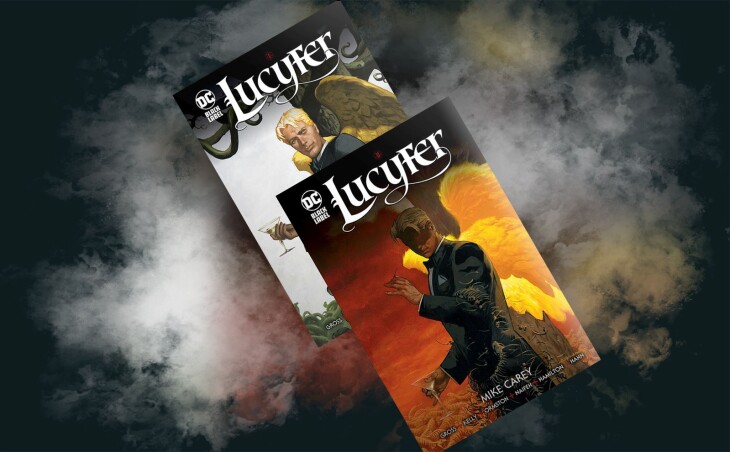Lucifer is a great comic. Great in terms of screenwriter Mike Carey’s ambition. It is also great because of the volume – the first two volumes are a trifle of over one thousand two hundred pages, collecting over fifty notebooks from the original edition.
With this amount of source material, it’s hard to avoid spoilers, so if someone doesn’t like them, jump two paragraphs away.
Full eclecticism
The David Bowie Face Lucifer originally appeared in the Sandman series by Neil Gaiman. Mike Carey won the Briton’s blessing, drove the Morning Star his way, and produced a rare example of a spin-off that is not inferior to the original. And that’s a great art.
The Carey series begins with Lucifer leaving Hell. Los Angeles has become a new home for the Fallen Angel, where the protagonist runs a nightclub called “Lux”. However, the tranquility of the Morning Star does not last long. To mention just a few of the dozens of plot threads, Lucifer comes to: fight off the invasion of angels ( aka pompous assholes who don’t care about mortal lives), regain wings, defeat Japanese gods of the afterlife or finally create his own … universe (sic!).
Carey freely juggles with motifs derived from religions from around the world and is not shy about reaching for even the strangest elements. Sometimes he also adds a lot of himself: “Basic” Christian Hell, where demons wear frock coats and wigs for some reason, looks like the demonic version of the prom from Jane Austen’s novel. And then it gets weirder and weirder. Suffice it to mention that at some point the heroes go on a journey on the ship “Naglfar” – made of the nails of the dead. Reading the comic book, it’s hard to predict in which direction Carey will lead the story, because it keeps taking new and unknown turns. This religious mishmash can be overwhelming at times, but at the same time there is something fascinating about this eclecticism.
Where the devil can’t? Pfff, the devil can do anything, anywhere
I have some reservations about the title character, although my problem with him is complex. Well, Lucifer shows crazy intelligence, it is impossible to outsmart him, because in every threat situation he can find a favorable solution. And inside the presented world, it has a justification, since Lucifer is second to God, which makes him an almost omnipotent being. From an outside perspective, however, the erstwhile ruler of Hell is getting dangerously close to the unfortunate “Gary Stu.” Because how can you worry about his fate when we know that he will come out victorious in every duel?
Fortunately, there are quite a few side characters in the comic. Well, Carey more than once pushes Lucifer to the background and devotes entire notebooks to other heroes. And very good, because their threads are often even more interesting than the main plot. He appears here, inter alia, Ellaine Belloc – a girl who sees ghosts, Jill Presto – an unfulfilled artist who allows tarot cards to take over her body or Maaziken, the right hand of the Morning Star, regaining her place among Lilim’s demons. Lucifer stands strong women. The advantages don’t end here, as Carey’s full control over the story allows him to pull the characters out of the third plan and give them an important mission to complete a few hundred pages later.
Ugly as hell?
With Sandman and LuciferI have the same problem. While the plot in both cases is a masterpiece, I can’t get fond of the graphics. I appreciate that practically every artist who draws the Morning Star has their own style and that the drawings are far from the average title published in the USA. However, in most cases, I have completely different canons of beauty than the artists who collaborate with Carey. Especially since my appetite was awakened by the first three notebooks drawn by Scott Hampton. However, the artist later opted out of this project and was replaced by Dean Ormston and Peter Gross, who alternately created the notebooks. In their case, the result can be very different. Ormston creates demons in an intriguing way, but both he and his partner in “crime” are far worse at portraying people.
Despite its impressive size, the Egmont edition was devoid of interesting additions. These few more pages would probably not make a difference, so it is a pity that it was not decided to enrich the comic with this type of content.
Enjoyable
Is the Lucifer series worth the sin? Of course. Two thick volumes can be a bit overwhelming and require reading in the right conditions (such a bathtub is average), but the content rewards it three times. Carey’s ambitions are enormous, yet it is rare to see the creation of the universe on the pages of a comic book. With this audacity the scriptwriter bought me and I hope that the ending of the threads in the third volume will be equally satisfying.
Nasza ocena: 7/10
Lucifer is a comic book worth sin.PLOT: 8/10
Characters: 7/10
GRAPHIC DESIGN: 5/10
EDITION: 8/10

